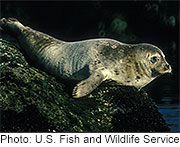- Skip Storing This Everyday Product in the Fridge Door
- Green Tea + B3 Pairing May Boost Brain Health
- Navigating Your Midlife Crisis: Embracing New Possibilities
- City Raccoons Showing Signs of Domestication
- Mapping the Exposome: Science Broadens Focus to Environmental Disease Triggers
- One Week Less on Social Media Linked to Better Mental Health
- Your Brain Changes in Stages as You Age, Study Finds
- Some Suicide Victims Show No Typical Warning Signs, Study Finds
- ByHeart Formula Faces Lawsuits After Babies Sickened With Botulism
- Switch to Vegan Diet Could Cut Your Greenhouse Gas Emissions in Half
Seals, Sea Lions Helped Global Spread of TB, Study Finds


New research reveals that, long ago, sea mammals may have played a role in the global spread of the infectious disease known as tuberculosis.
Ancient strains of tuberculosis spread from people in Africa to seals and sea lions, who then spread it to people in South America thousands of years ago, according to an international team of researchers.
“Tuberculosis is a disease that is on the rise again worldwide. This study and further research will help us understand how the disease is transmitted and how the disease may evolve,” study collaborator Jane Buikstra, director of the Center for Bioarchaeological Research at Arizona State University, said in a university news release.
Along with offering new insight into one of the most persistent and deadliest infections, the findings may help improve understanding about how other infectious diseases — such as SARS (severe acute respiratory syndrome), MERS (Middle East respiratory syndrome) and HIV — are transmitted between species and how they spread, the researchers said.
The study team concluded that tuberculosis spread from people in Africa to seals and sea lions about 6,000 years ago. The sea mammals then carried the disease to South America and transmitted it to people there 5,000 years later.
However, those older strains of tuberculosis were completely replaced by other strains of the disease after Europeans arrived in the Americas. Modern tuberculosis strains are most closely related to those found in Europe, according to the report published Aug. 20 in the journal Nature.
“We found that the [older] tuberculosis strains were most closely related to strains in pinnipeds, which are seals and sea lions,” Anne Stone, a professor in Arizona State University’s School of Human Evolution and Social Change, said in the news release.
“What we found was really surprising. The ancient strains are distinct from any known human-adapted tuberculosis strain,” she added.
Study co-first author Kelly Harkins pointed out in the news release that “it was a surprise for all of us to find that tuberculosis, formerly believed to have spread around the world with ancient human migration events, is in fact a relatively young disease.” Harkins is a recent doctoral graduate from the university’s Center for Bioarchaeological Research.
Another co-first author, Kirsten Bos, a postdoctoral fellow at the University of Tuebingen in Germany, added: “A compelling prospect for future research will be to determine the relationship of these older forms to those currently circulating, and those isolated from other ancient remains.”
Tuberculosis kills 1 million to 2 million people worldwide each year. The bacteria that cause tuberculosis are spread from one person to another through tiny droplets released into the air when an infected person coughs or sneezes.
More information
The U.S. National Library of Medicine has more about tuberculosis.
Source: HealthDay
Copyright © 2025 HealthDay. All rights reserved.










